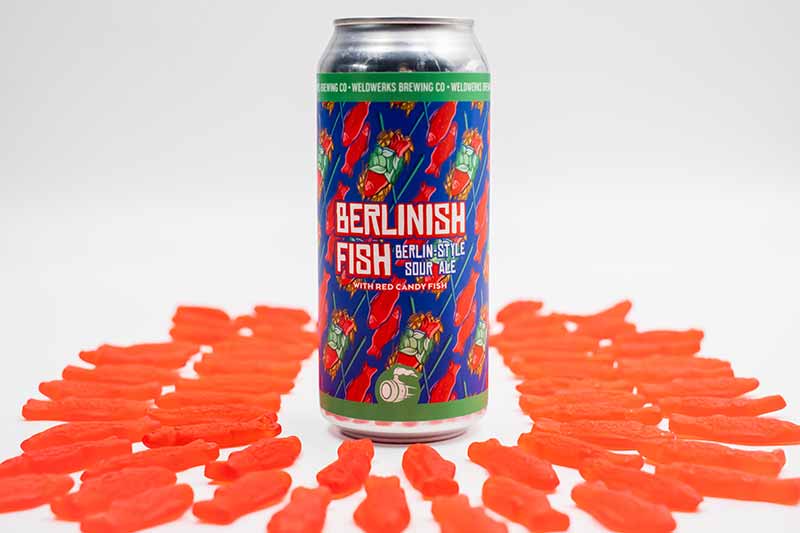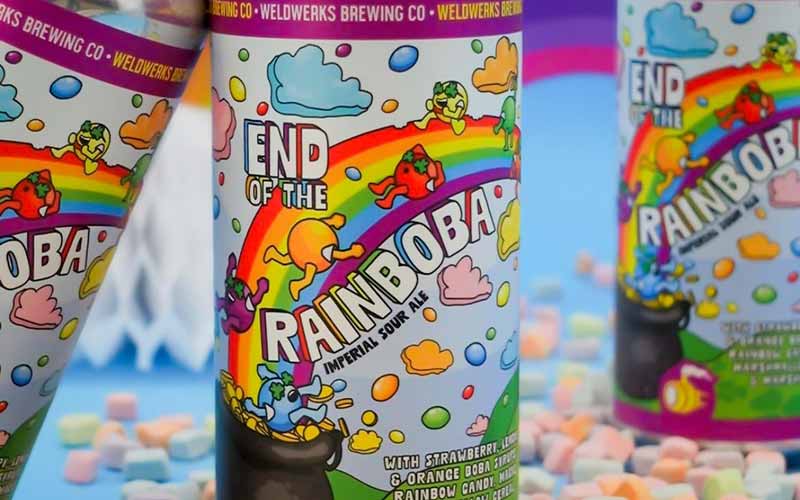
We’ve highlighted how to brew with several of the most popular adjuncts—coconut, chocolate, honey, and fruit purees—that can make your finished product pop. With the popularity of pastry stouts hitting a total of three hundred thousand ratings on Untappd last year, candy is another one that brewers use to take a finished beer to a different level.
We chatted with Mortalis Brewing, WeldWerks Brewing, and Settle Down Beer* to learn what they aim to achieve by adding candy, the best type to use, when and how much to add, and which beer style best suits this playful adjunct.
*Editor’s Note: Giovanni Albanese Jr. is the co-owner of and brewer for Settle Down Beer. Anything pertaining to Settle Down is separate from that of Next Glass.
(Above photography courtesy of WeldWerks Brewing Co.)
What We’ll Cover in This Piece:
Affordable, Industry-Leading Brewery Software
What Do the Experts Hope to Achieve by Adding Fruity Candy to Beer?

Photography courtesy of Mortalis Brewing
Mortalis CEO and Co-Owner Paul Grenier says plenty of great extracts impart a very true-to-candy aroma with a touch of flavor. They are looking for more with their candy additions.
“We prefer to focus on the real candy ingredient because it lends to the most concentrated authentic flavor,” Grenier says. “I am not a candy maker, but I certainly know what I like. Something about many of the candy ingredients we use in beer is just a Willy Wonka level when you get to taste it.”
Grenier adds, “My partner, Dave Luckenbach, [co-owner of Mortalis,] put it best as he describes our candy beers: ‘The real ingredient is just pure [bleeping] magic; no real substitute.’”
WeldWerks Head Brewer Skip Schwartz says the ultimate goal of using candy in beer is all about how it translates into the customer’s glass.
“When brewing with candy, our primary goal is to extract flavor and aroma from the candy rather than fermentable sugars into the final product,” Schwartz says. “We calculate the sugar content of the candy to ensure that we properly account for it in the ABV on the label.”
If you have a sweet tooth, brewing with candy has an added benefit.
“One enjoyable aspect of brewing with candy is the opportunity to snack on it beforehand,” Schwartz says. “It’s crucial to conduct ingredient quality control to ensure the best results possible.”
Grenier adds that you should give yourself a little extra time when making a beer with candy to account for any issues.
“Don’t be afraid to try it, even if you’re small batching a single keg just for your taproom,” Grenier says. “Allow yourself to have some fun with it, experiment with it, and maybe, for a minute, feel like a kid again.”
Settle Down Co-Owner and Brewer Robert Anderson agrees that he wants the candy to shine through and be noticeable.
“We’re hoping that the beer will taste like the candy you use,” Anderson says. “We really want people to sip the beer and be like, ‘Wow! You can really taste the Nerds!’”
Anderson also hopes the candy will be a complementary piece to the base beer.
What Is the Best Type of Fruity Candy to Use in the Brewing Process?

Photography courtesy of Settle Down Beer
There are many types of candy in the market, including hard, gummy, and taffy, to name a few. But which confections are optimal for brewing?
“Hard candy for sure because it dissolves fully,” Anderson says. “And you don’t have to worry about a huge mess.”
Grenier adds, “Hard candy is the absolute best to work with. You are looking for something that is going to properly dissolve with the least amount of time and effort.”
Despite playing around with all kinds of candy, Schwartz says WeldWerks had the best results with one particular type.
“Gummy candy has been the easiest from our experience,” he says.
Grenier says they’ve worked with all types of candy and that the choice depends on what you’re trying to achieve in the beer.
“The more you work with Nerds or Skittles, the more you understand that it’s nearly impossible to recreate those flavors,” Grenier says. “And the beer design should be more focused on complementing those candy flavors and enhancing them.”
When Do You Add Fruity Candy in the Brewing Process?

Photography courtesy of WeldWerks Brewing Co.
Grenier says ninety-five percent of the time, Mortalis adds candy on the cold side.
“Usually in a hopback to recirculate the beer on a particular candy,” Grenier says. “Each candy is very different in the way it reacts to the process, so there is always a trial and error when working with certain candies for the first time.”
For its Four Eyes sour TIPA, Settle Down adds Rainbow Nerds in the whirlpool.
“Using it there, it dissolves easier,” Anderson says. “And you get more of the flavor from the candy.”
Schwartz says Weldwerks uses gummies in multiple phases.
“Both the hot side, typically during the boil,” he says. “And on the cold side, within our custom adjunct tanks.”
How Much Fruity Candy Should You Add?

Photography courtesy of Mortalis Brewing
Like dry hopping and fruit additions, Schwartz says you can undershoot or overdo candy in a beer. WeldWerks factors in several things when deciding how much candy to add.
“We vary the amounts we use depending on the beer style, our desired outcome, and our experience,” Schwartz says. “The quantities are based on past experiences with similar candies, but they are essentially estimates.”
He adds, “Occasionally, we get lucky and achieve the desired flavors on our first attempt.”
Grenier echoes Schwartz.
“We find the best advice is to start on the smaller side when performing the recirculation,” Grenier says. “You can always add more, but you rarely can go back if you overdo it.”
Grenier says how much they use depends on the candy itself. In their annual Red + White + Blue Sour collab with Arkane Aleworks, they use two different types of Skittles and put between 175 to 200 pounds of Skittles in a 20BBL batch.
“This took us some trial and error in numbers to get the flavor saturation right,” Grenier says. “And it varies via the candy chosen.”
Settle Down has brewed Four Eyes on a smaller scale—around three barrels at a time.
“We messed around with the amount of Nerds we put in our beer over the batches we’ve done,” Anderson says. “But we locked into a figure of about thirteen pounds per barrel that gets us what we want in the finished beer.”
Grenier says that while the goal is to get the flavor in the finished product, candy is loaded with sugar, so you have to account for that.
“It certainly imparts extra sugar to the process,” he says. “So blending with certain acids and making pH adjustments can be crucial to not having a total sugar bomb.”
Which Beer Style Best Showcases Fruity Candy?

Photography courtesy of WeldWerks Brewing Co.
Mortalis loves adding candy to a fruited sour.
“Getting to blend fruits and adjuncts to enhance those flavors from childhood is an absolute dream for us,” Grenier says. “When you can focus on the layering of the flavors to help enhance the candy, that’s when the magic happens.”
Schwartz says depending on the adjunct, the beer selection will change.
“Sours pair excellently with any type of fruit candy,” he says. “While stouts excel with chocolate additions.”
Settle Down likes to add candy into a sour beer but found an excellent result in a sour triple IPA.
“We really like the base triple IPA we made with Mosaic and Strata hops,” Anderson says, “And thought that would do really well as a sour triple IPA when paired with the Nerds. We gave it a whirl, and it turns out it’s really tasty.”
Anderson adds, “And best of all, our customers love it.”
Three Great Examples of Fruity Candy in Beer

Photography courtesy of Mortalis Brewing
Settle Down uses Nerds in its Four Eyes sour triple IPA, a 10% ABV beer with Strata and Mosaic hops.
“The Nerds flavor and aroma really come through with this beer,” Anderson says. “It’s a fun beer. The Nerds are easy to incorporate and help bump up the ABV a little while bringing a great taste to the finished beer. How could it be bad?”
WeldWerks uses Swedish Fish candy in its 4.2% ABV Berlinish Fish, a Berliner Weisse-style sour that uses the candy.
“It’s a super fun beer,” Schwartz says. “And we’ve perfected the flavor of the Swedish Fish.”
Schwartz adds that another candy beer WeldWerks made this year for St. Patrick’s Day, End of the Rainboba, utilized Skittles, which turned out “amazingly well.”
Mortalis has worked with many different candies over the years, including Starburst, Nerds, Skittles, and grape gummy bears, but one beer stands out: Gemini I Strawberry + Kiwi + Starburst. A part of the brewery’s Gemini series, the 7% ABV smoothie sour features strawberry, kiwi fruit, and STARBURST® candy.
“This beer is a total pain to make and requires twelve man hours alone to melt down and liquefy the STARBURST® candies before filtering the wax coating and then properly adding it to the beer,” Grenier says. “It’s a true labor of love … but when we try it, you just get transported back in time, and that really makes it worth it for us.”



